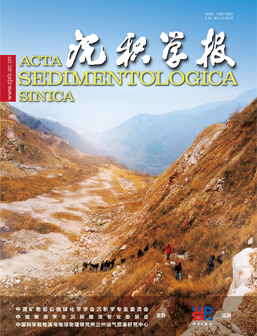Paleogeographic pattern of carbonate platform in the middle-upper Yangtze area during the deposition of the Ediacaran Dengying Formation and distribution pattern of reservoir facies
doi: 10.14027/j.issn.1000-0550.2023.135
- Received Date: 2023-05-10
- Available Online: 2024-04-09
-
Key words:
- middle-upper Yangtze area /
- Dengying Formation /
- carbonate platform /
- paleogeographic pattern /
- reservoir facies
Abstract: The dispute in paleogeographic pattern of the carbonate platform and distribution of reservoir facies during the deposition of the Dengying Formation in the middle-upper area, hinders the expansion of the exploration domain from the Mianyang-Changning intracratonic sag to other areas. Thus, this study investigates more than 30 sections (wells), and further confirms that the shoal-reef is marked by massive peloidal/ooidal dolograinstone and columnar, domal dolostromatolite, which were deposited around the platform (or inner ramp) margin of the middle-upper Yangtze Platform gradually shifting outward into tempestite of the middle-outer ramp or slump dolobreccia, argillaceous dolomite and chert of slope-basin facies. Due to the shoal-reef barrier, its back was dominated by tidal flat and lagoon. Of these, the tidal flat facies were marked by microbial dololaminite, domal dolostromatolite, dolothrombolite with minor peloidal dolograinstone and dolomudstone, which are commonly arranged into meter-centimeter scale cycles. The lagoon facies were composed mainly of dolomudstone and peloidal dolowackestone. The spatio-temporal distributions of these facies show a generally progradational trend of the Dengying Formation on the middle-upper Yangtze Platform, which consists of 2.5 depositional sequences with 3 progradations (shallowing) and 2 retrogradations (deepening). Owing to the denuation of the Dengying Formation at the platform margin-slope area, and upper Yangtze Platform beyond the current plate boundary, the platform marginal shoal-reef facies are locally present in the Deng 4 Member. In this case, some areas (e.g., Songlin and the periphery of the middle Yangtze Platform) with platform marginal shoal-reef facies in the lower-middle Dengying Formation (Deng 1 to 2 or Hamajing to Shibantan members), are important exploration targets. Moreover, the lower Deng 2 Member and upper Deng 4 Member (or coeval strata) formed during progradations composed mainly of microbial dolomite throughout the middle-upper Yangtze Platform (or inner ramp) interior, are also important exploration targets. Because the microbial dolomite was widely developed throughout the middle-upper Yangtze Platform interior, decoding the formation mechanism and distribution pattern of high-quality reservoir is the key to find new hydrocarbon provinces.
| Citation: | Paleogeographic pattern of carbonate platform in the middle-upper Yangtze area during the deposition of the Ediacaran Dengying Formation and distribution pattern of reservoir facies[J]. Acta Sedimentologica Sinica. doi: 10.14027/j.issn.1000-0550.2023.135 |






 DownLoad:
DownLoad: